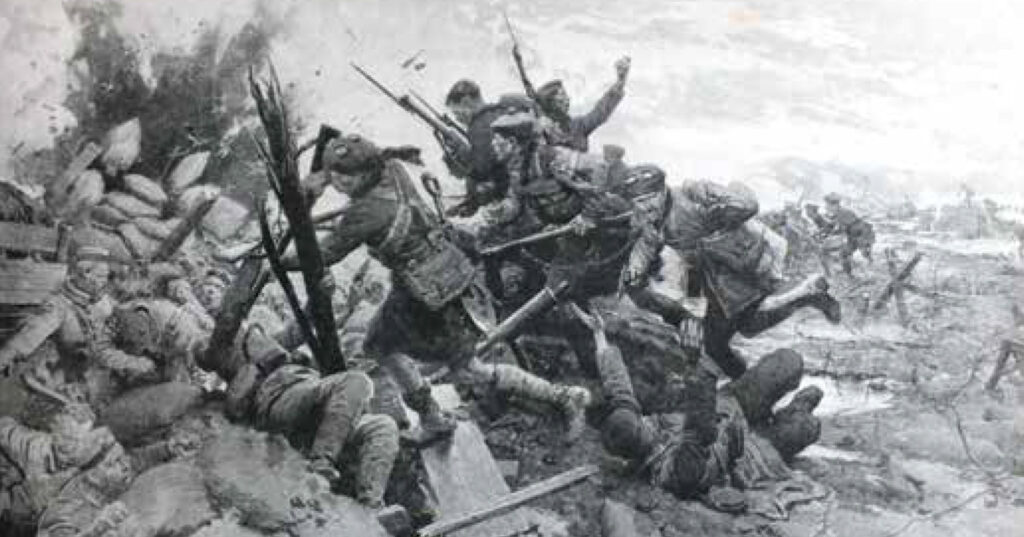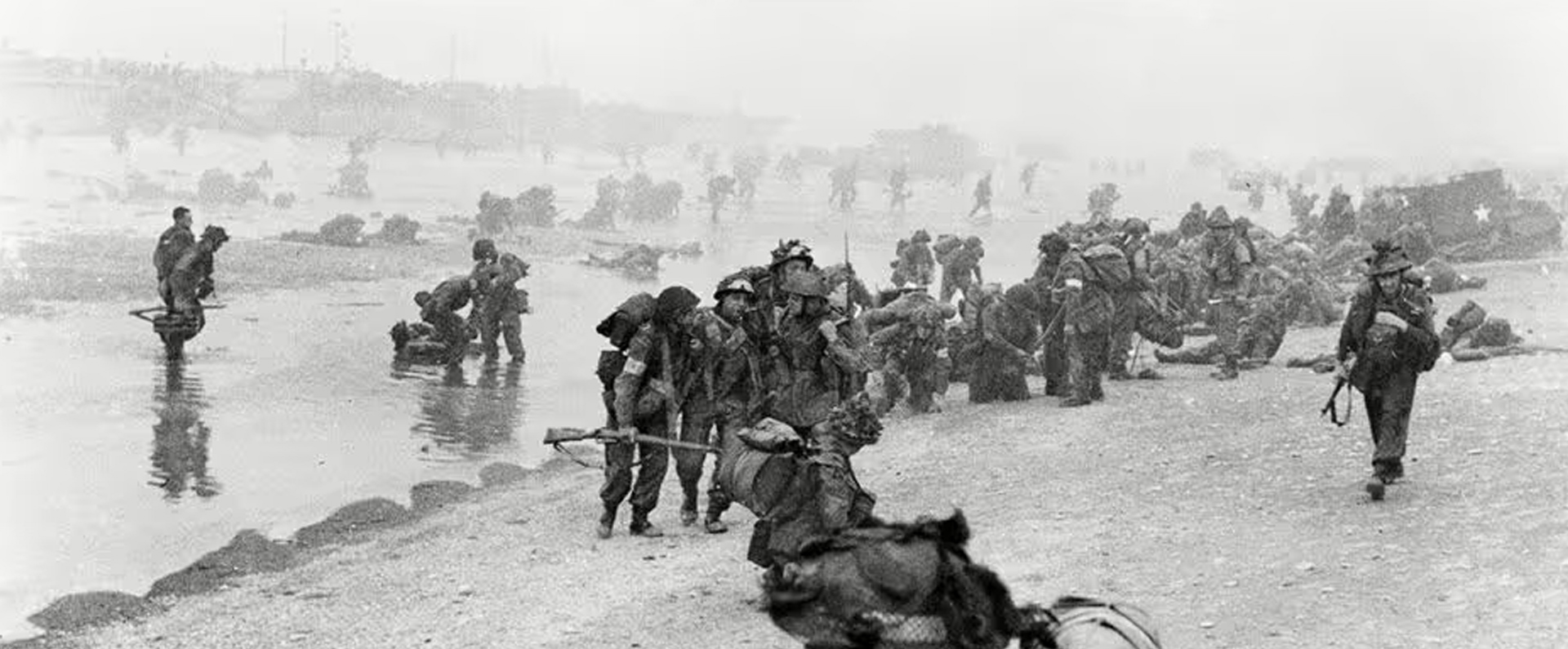
Published in Britain at War in November 2015.
Sergeant-Piper Daniel Laidlaw: boldness
Daniel Logan Laidlaw was born in Little Swinton, Berwickshire, on 26 July 1875. He was one of four sons of Robert and Margaret Laidlaw, who lived in Coldingham, Berwickshire. After attending the National Schools at Berwick-upon-Tweed and Lesbury, Northumberland, Laidlaw joined the Army on 11 April 1896.
Until June 1898, he served in India with the Durham Light Infantry. Next, Laidlaw served as a piper in the King’s Own Scottish Borderers (KOSB) until 11 April 1912. On 11 April 1906, he had married Georgina Harvie at the Baptist Church, Alnwick, Northumberland, and the couple went on to have five children: three sons and two daughters.
After returning from India in 1912, Laidlaw was put on the Reserve and during this time his civilian jobs included working as a canteen manager and at a horse-breeding centre. After the outbreak of war, Laidlaw re-enlisted in the KOSB on 1 September 1914 and, in June 1915, he travelled to France as part of the regiment’s 7th (Service) Battalion.
The 7th was selected as an assault battalion for the approaching Battle of Loos and its men, including Laidlaw, trained for four weeks at Labeuvrière, near Béthune. On the night of 24 September 1915, they went to their assembly trenches and the two leading brigades (44th and 46th) were initially tasked with capturing the Lens Road and the Loos Road Redoubts.
The battle began in earnest early the next day, 25 September, and, after the final bombardment of the enemy close to Loos and Hill 70, the 7th KOSB waited for the release of poison gas and smoke on the German lines. However, the adverse weather blew the gas back towards the British positions and troops manning the trenches were badly affected. Amid chaotic scenes, the 7th was ordered to attack at 6.30am but everyone stayed where they were. 2nd Lieutenant Martin Young, the company commander, realised inspiration was required in the difficult circumstances and he shouted at Piper Laidlaw: “For God’s sake, Laidlaw, pipe ‘em together.”
Laidlaw seized the moment, and disregarding the gas and the heavy enemy bombardment, advanced over the parapet, accompanied by Young, and marched up and down playing “Blue Bonnets over the Border.” Encouraged by the skirl of the pipes and roused by Young’s call for action, the men of the 7th Battalion went “over the top” and other troops soon followed.
As the sole piper in no-man’s land, Laidlaw was the obvious target for the enemy but he initially escaped injury. However, as he advanced towards the enemy lines, still playing his pipes, he was hit in his left leg and ankle by shrapnel. Limping forwards, he switched his tune to “The Standard on the Braes o’ Mar” but soon he was wounded again by shrapnel, further injuring his left leg. With the battle won, Laidlaw hobbled back to the British trenches, dragging his beloved bagpipes with him.
Laidlaw later recalled: “I kept on piping an piping, and hobbling after the laddies until I could go no farther, and then, seeing that the boys had won the position, I began to get back as best I could to our own trenches.” He said that his once black hair had turned white within hours of his VC action.
On the very day of his bravery, Laidlaw was promoted to corporal for his distinguished service in the field. Sadly, the equally inspirational 2nd Lieutenant Young, who had been severely wounded in the fighting but who insisted on walking to the dressing station rather than being stretchered there, died from loss of blood. Over their three days of fighting until 27 September, the 7th Battalion suffered 656 casualties (dead and wounded).
Laidlaw’s VC was announced on 18 November 1915 when his citation detailed how he had “played his company out of the trench”. His citation concluded: “The effect of his splendid example was immediate, and the company dashed out to the assault. Piper Laidlaw continued playing his pipes until he was wounded.” He received his VC from George V in an investiture at Buckingham Palace on 4 December 1915, while still recuperating from his injuries. Laidlaw was also awarded the French Croix de Guerre.
Laidlaw’s wounds were treated at Lord Derby’s Hospital, near Warrington, Lancashire, but he eventually returned to serve in France. He was promoted to sergeant-piper on 12 October 1917, his final rank, and survived the war before being demobbed on 3 April 1919 after 22 years and two months of service.
After leaving the military and despite of being a VC recipient, Laidlaw found it difficult to find regular employment. For a time he worked at the Sunderland shipyards but during the recession he was unemployed for some eight years. In 1929, however, he re-enacted his VC action for the film “Guns of Loos” and in 1934 he also took part in the film “Forgotten Men”. By now, Laidlaw was affectionately known as the “Piper of Loos” of sometimes just “the Piper’. For a time, Laidlaw worked as a chicken farmer and, from 1938, as sub postmaster at Shoresdean, near Berwick-upon-Tweed. After the outbreak of the Second World War, his son, Victor joined the KOSB in 1940, aged 20.
Laidlaw died at his home in Shoresdean on 2 June 1950, aged 74, and hundreds of mourners attended his funeral. Memorials in his honour include a plaque on a wall at St Cuthbert’s Church, Norham, the venue for his funeral. His VC medal group was donated to the National War Museum of Scotland on 25 September 2005 when, to mark the 90th anniversary of the Battle of Loos, pipers, including Laidlaw’s great grandson, re-enacted his VC action at the spot where he had stepped on to the trench parapet in 1915.
Download a PDF of the original Britain at War article
For more information, visit:
LordAshcroftOnBravery.com


